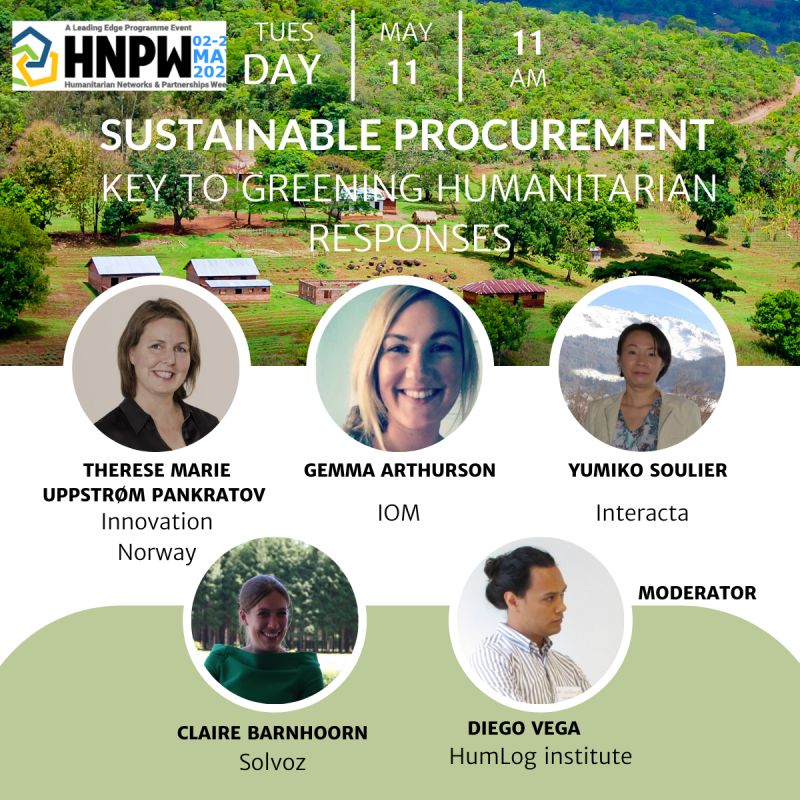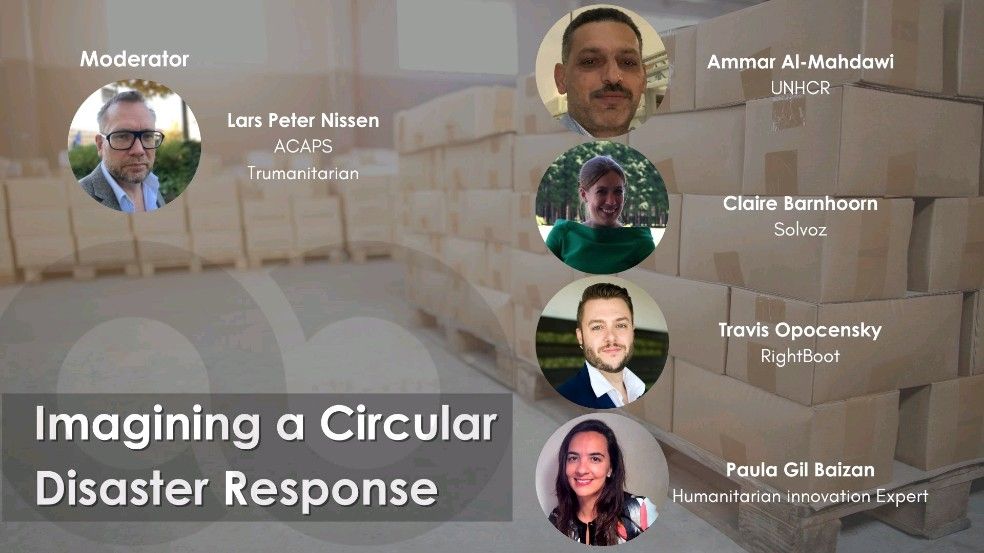It’s a wrap HNPW22: a conference in person!
The buzz of a conference, the energy from literally ‘bumping’ into old friends, colleagues, and sector specialists, was just great. I realized how much I had missed this during all the years of lockdowns and COVID.
What a week it has been! I am very thankful for the great and personal interactions during the Humanitarian Network and Partnerships Week (HNPW) in Geneva last week. I spent a full week in Geneva, from the 9th till the 13th of May (okay, 14th, my flight got cancelled in the end). It was great to present our work with Solvoz and IOM around greening humanitarian responses by addressing the e-waste challenge. But I am also excited to be requested in a panel to share my vision on circularity in humanitarian responses. I think far too often, there is much blabla, greenwashing by just mentioning it or having a policy report on it – but it all starts with what we buy in the first place. Procurement might be seriously dull for most, but it’s the key to enabling change. If we push for the cheapest products, which might be unrepairable, toxic or unrecyclable, we just keep building these massive waste piles

Introducing HNPW
The Humanitarian Networks and Partnerships Week (HNPW) is an annual humanitarian conference, one of the most significant events of its kind, that provides a collaborative space for practitioners and experts from a large variety of humanitarian stakeholders, including UN agencies, NGOs, the Red Cross, and Red Crescent Movement, academia, the military, private sector initiatives, and the Member States.
The event was first held in 2015 upon a recommendation from the Member States and the stakeholders of Humanitarian Networks and Partnerships to hold their annual meetings at the exact location and to provide an opportunity for professionals working in the humanitarian sector to exchange experience, discuss new concepts, introduce new tools and ideas, connect, and collaborate in finding solutions to common challenges in crisis preparedness and response. In addition to network and partnership meetings, the HNPW 2022 offered a wide variety of cross-networks interactive sessions, briefings, technical discussions, and an exhibition area, where participants exchange experience and have the opportunity to network with professionals and experts across many sectors.
Sustainable procurement – session in greening humanitarian responses by closing the loop in displacement settings
I am thankful to UNOCHA, giving us the opportunity to present our session as part of the agenda on Wednesday 11th of May. This session was co-hosted by Innovation Norway and IOM-UN Wash on the importance of sustainable procurement. It showcased the first outcomes of our work on sustainable procurement and the e-waste partnership pilot Solvoz is currently taking part in. Aside from this session, throughout the whole week, whether it was in other organised sessions or in bi-lateral meetings, I found myself consistently discussing the importance of sustainable procurement to contributing to greening humanitarian responses. You can not imagine how excited I was. Having an active dialogue, with actionable outcomes will help to ensure that going forward such concerns are placed at the centre of discussions with both donors and manufacturers (as well as INGOs, UN agencies, and NGOs) as well as emphasizing our individual roles in greening humanitarian responses.
During the session I got a rather sceptical question from the audience, that it was great all this greening, but that it would never be possible to get more green products from suppliers. I personally truly believe this is far too often used as an excuse, since “what you request is what you can get.” A remark that came back so many times since that meeting in other sessions…

"What you request is what you can get."
If we do not get our technical specifications and requirements right, we wont get a lantern with less toxic batteries… or a repairable lantern. This all comes back to integrating considerations of the (end of) life and life cycle of solutions (e.g., products, kits, services) into our procurement processes. When we incorporate sustainability criteria into these processes, we are then able to request more sustainable products and services, including for example, solutions with improved repairability and #recyclability. Whilst a 100% sustainable supply chain may not be achievable tomorrow, we can take important steps towards a more sustainable sector by beginning to adopt and promote these criteria. We already routinely make demands about the working practices and regulations of our suppliers and manufactures, for example requests that prohibit the use of child labour. We must now also begin to demand the incorporation of key sustainability criteria into our supplier’s practices to facilitate and encourage the development of products that can be more easily repaired, reused and recycled. This process begins by proactively promoting the knowledge acquired from technical subject experts and operations so it is available to systematically incorporate into procurement dossiers.
Imagining a circular disaster response
The other session whereby I could share my vision regaring how to move to green our humanitarian respones been the circular disaster response session. I was fortunate to be requested in this panel that was hosted by Lars Peter Nissen. A discussion following this session ultimately led to a podcast (see here) too. If you wish to still see or listen in to this session, it is available online here.

The panel introduction: Humanitarian organizations, like organizations across all disciplines and sectors, are being increasingly held to account for the waste we create, for our carbon footprint, and the impact of our operations on local environments. Many experts say that a circular and regenerative economy is the model we all must adopt in order to continue human presence on this planet. So then, what does the transition to a ‘cradle to cradle’ system look like for the humanitarian and disaster response sectors? Using the principles of a circular economy as a lens: Eliminate waste and pollution Circulate products and materials at their highest value Regenerate nature This panel tries to build a collective vision of what this Circular Aid Economy might look like and what are the necessary steps we must take to get there.
